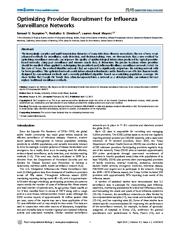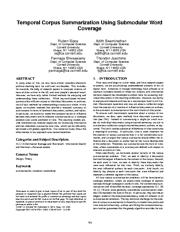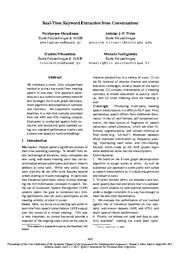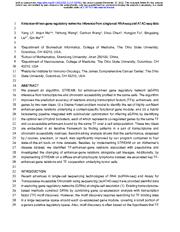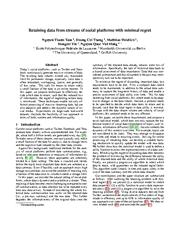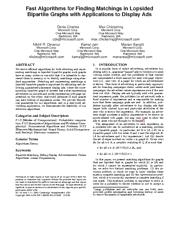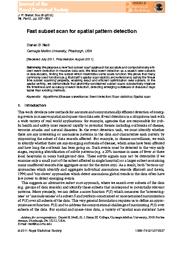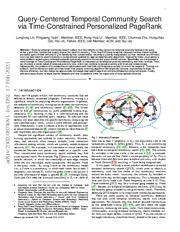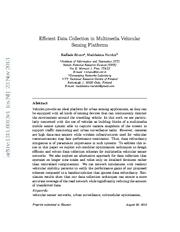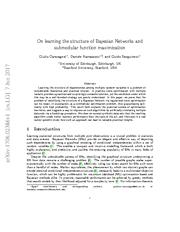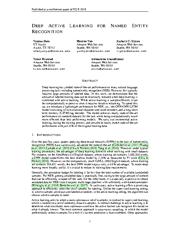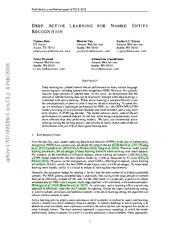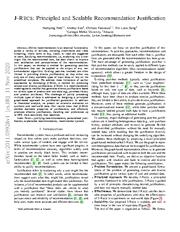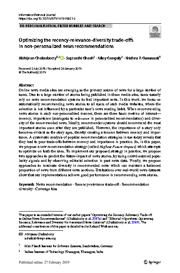A copy of this work was available on the public web and has been preserved in the Wayback Machine. The capture dates from 2017; you can also visit the original URL.
The file type is application/pdf.
Filters
Optimizing Provider Recruitment for Influenza Surveillance Networks
2012
PLoS Computational Biology
Here, we demonstrate that a new method for optimizing surveillance networks can improve the quality of epidemiological information produced by typical providerbased networks. ...
This optimized network avoids informational redundancies and is thereby more effective than networks designed by conventional methods and a recently published algorithm based on maximizing population coverage ...
Internet data streams. ...
doi:10.1371/journal.pcbi.1002472
pmid:22511860
pmcid:PMC3325176
fatcat:l4ry2uywp5aizedwc35qj6y6cm
Temporal corpus summarization using submodular word coverage
2012
Proceedings of the 21st ACM international conference on Information and knowledge management - CIKM '12
The resulting models provide monotone sub-modular objectives for computing informative and non-redundant summaries over time, which can be efficiently optimized with greedy algorithms. ...
In this paper, we explore methods that provide a temporal summary of such corpora in terms of landmark documents, authors, and topics. ...
NIPS
CONCLUSIONS This paper presented a submodular framework for temporal corpus summarization. ...
doi:10.1145/2396761.2396857
dblp:conf/cikm/SiposSSJ12
fatcat:khybsq2t3zg6fmsw3gjzv2qudi
Real-Time Keyword Extraction from Conversations
2017
Proceedings of the 15th Conference of the European Chapter of the Association for Computational Linguistics: Volume 2, Short Papers
Our approach represents text as a word co-occurrence network and leverages the k-core graph decomposition algorithm and properties of submodular functions. ...
To select the best terms, we propose a new keyword quality function and prove that it is submodular, which enables its near-optimal optimization under a budget constraint in a way fast enough to meet the ...
Optimization task. ...
doi:10.18653/v1/e17-2074
dblp:conf/eacl/VazirgiannisTMN17
fatcat:eeuaqqivzfczreblh5pznqvosy
Enhancer-driven gene regulatory networks inference from single-cell RNA-seq and ATAC-seq data
[article]
2022
bioRxiv
pre-print
optimization for inferring eGRNs by identifying the optimal set of hybrid biclusters, each of which represents co-regulated genes by the same TF and co-accessible enhancers bound by the same TF over a ...
Steiner forest problem model to identify the set of highly confident enhancer-gene relations underlying a context-specific functional gene module; and (ii) a hybrid biclustering pipeline integrated with submodular ...
(C) Submodular optimization based on HBCs to construct eRegulons. ...
doi:10.1101/2022.12.15.520582
fatcat:ssaoinoq4vgp3ot7u6jbtvmmma
Retaining Data from Streams of Social Platforms with Minimal Regret
2017
Proceedings of the Twenty-Sixth International Joint Conference on Artificial Intelligence
These techniques enable not only efficient processing of massive streaming data, but are also adaptive and address the dynamic nature of social media. ...
The resulting data streams exceed any reasonable limit for permanent storage, especially since data is often redundant, overlapping, sparse, and generally of low value. ...
Thus, an optimal selection remains optimal after the utility has been updated. ...
doi:10.24963/ijcai.2017/397
dblp:conf/ijcai/TamWTYH17
fatcat:hbp3msub2zfjjektywma4svcpe
Fast algorithms for finding matchings in lopsided bipartite graphs with applications to display ads
2010
Proceedings of the 11th ACM conference on Electronic commerce - EC '10
In fact this choice is better than optimizing as mentioned above, because this choice is biased towards the YES case. ...
LP to Minimize a Submodular function Lemma 10. LP (5) captures the problem of minimizing the submodular function ψ. ...
doi:10.1145/1807342.1807362
dblp:conf/sigecom/CharlesCDJS10
fatcat:evnte6qeozfern4k4fxo2hthsa
Fast subset scan for spatial pattern detection
2012
Journal of The Royal Statistical Society Series B-statistical Methodology
Kulldorff's spatial scan statistic and extensions) satisfy the 'linear time subset scanning' property, enabling exact and efficient optimization over subsets. ...
For multiple subsets of streams, or varying temporal window sizes, we can perform a separate optimization for each, and then maximize over all subsets of streams and temporal window sizes under consideration ...
For any given spatial region S (and a fixed temporal window W ), we can efficiently optimize over all subsets of streams. ...
doi:10.1111/j.1467-9868.2011.01014.x
fatcat:zasxo5xw7bf2jb36xczxoxjs3i
Query-Centered Temporal Community Search via Time-Constrained Personalized PageRank
[article]
2023
arXiv
pre-print
Subsequently, our problem is formulated as an optimization task that finds a β-temporal proximity core with the largest β. ...
Then, we introduce a model called β-temporal proximity core, which can combine temporal proximity and structural cohesiveness. ...
Thus, ρ H (w) ≥ ρ H (u) ≥ ρ S (u), which implies that H has optimal minimum query-biased temporal degree. ...
arXiv:2302.08740v1
fatcat:kgdodec6ofhflmj6awdn4uu7um
Efficient Data Collection in Multimedia Vehicular Sensing Platforms
[article]
2013
arXiv
pre-print
Then, we exploit these metrics to formulate the optimal data collection problem under network capacity constraints as a class of submodular set-covering problems. ...
function on I n is submodular when γ e (X , I o , T ) is submodular [20] and ii) the sum of submodular functions is submodular. ...
arXiv:1311.6013v1
fatcat:sitb3szstvdmnj3rc4u7erkpdi
Learning the structure of Bayesian Networks via the bootstrap
[article]
2021
arXiv
pre-print
By using several synthetic data sets, we show that our algorithm yields better recovery performance than the state of the art, increasing the chances of identifying a globally-optimal solution to the learning ...
This is consistent with greedy optimization of submodular functions. ...
Similarly to convexity and concavity in continuous optimization 3 , submodularity allows to efficiently find provably (near-)optimal solutions. ...
arXiv:1706.02386v2
fatcat:bcy4bhcqzzafhmanjlid36kpye
Deep Active Learning for Named Entity Recognition
2017
Proceedings of the 2nd Workshop on Representation Learning for NLP
Following , we express the problem of maximizing representativeness of a labeled set as a submodular optimization problem, and provide an efficient streaming algorithm adapted to use a constraint suitable ...
Following , we express the problem of maximizing representativeness of a labeled set as a submodular optimization problem, and provide an efficient streaming algorithm adapted to use a constraint suitable ...
Second, even with the state-of-the-art submodular optimization algorithms, the optimization problem (6) can be computationally intractable. ...
doi:10.18653/v1/w17-2630
dblp:conf/rep4nlp/ShenYLKA17
fatcat:nmiykn7gszamjbhkxsq5h7zqsq
Deep Active Learning for Named Entity Recognition
[article]
2018
arXiv
pre-print
Following , we express the problem of maximizing representativeness of a labeled set as a submodular optimization problem, and provide an efficient streaming algorithm adapted to use a constraint suitable ...
Following , we express the problem of maximizing representativeness of a labeled set as a submodular optimization problem, and provide an efficient streaming algorithm adapted to use a constraint suitable ...
Second, even with the state-of-the-art submodular optimization algorithms, the optimization problem (6) can be computationally intractable. ...
arXiv:1707.05928v3
fatcat:4yhcmcdvqvaedif7tzzw2p7paq
J-Recs: Principled and Scalable Recommendation Justification
[article]
2020
arXiv
pre-print
Online recommendation is an essential functionality across a variety of services, including e-commerce and video streaming, where items to buy, watch, or read are suggested to users. ...
Instead, we show that the objective (17) is submodular, which allows us to efficiently obtain near-optimal justifications. Theorem 1. ...
, is also submodular. ...
arXiv:2011.05928v1
fatcat:3dqm6aqazzbc5fcmwiapv7ewza
Optimizing the recency-relevance-diversity trade-offs in non-personalized news recommendations
2019
Information retrieval (Boston)
So, in this paper, we propose a new recommendation strategy (called Highest Future-Impact) which attempts to optimize on both the axes. ...
We investigate such biases in this section. ...
Inculcating diversity in recommended news Apart from the temporal bias identified in the last section, recommending stories based only on their future-impact values can overwhelm the recommendation stream ...
doi:10.1007/s10791-019-09351-2
fatcat:xmpk2hha25cbzhowialrl4npuy
Optimizing the Recency-Relevancy Trade-off in Online News Recommendations
2017
Proceedings of the 26th International Conference on World Wide Web - WWW '17
So, in this paper, we propose a new recommendation strategy (called Highest Future-Impact) which attempts to optimize on both the axes. ...
We investigate such biases in this section. ...
Inculcating diversity in recommended news Apart from the temporal bias identified in the last section, recommending stories based only on their future-impact values can overwhelm the recommendation stream ...
doi:10.1145/3038912.3052656
dblp:conf/www/ChakrabortyGGG17
fatcat:46gndh3kkrc3njhuqbxnslbvne
« Previous
Showing results 1 — 15 out of 135 results

